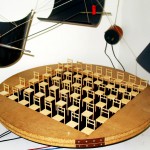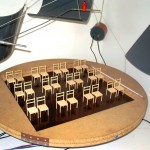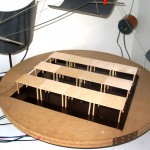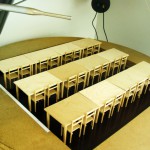General
In recent years, the scattering coefficient has been more and more integrated in room acoustics computer simulation as it significantly improves the precision and accuracy of simulation results [1,2]. The scattering coefficient offers a handy description of diffuse reflections of the sound field: it is defined as the ratio of the non-specularly reflected sound energy to the totally reflected energy [3]. The measurement method has already been developed and standardized by ISO [4]. Nowadays, the available scattering coefficient data are mainly related to architectural surfaces with different patterns and structures [5]. A lot of effort has also been put on the determination of numerical methods for calculating this coefficient beforehand [6,7]. Despite all, investigation on common objects has rarely been performed and there is still a lack of scattering coefficient data, especially for items that are commonly present in closed spaces, such as chairs, desks, bookshelves. This aspect is of primary interest particularly for environments, such as classrooms, churches or concert halls, where furniture constitute a large part of the total scattering surface.
Measurements
Measurements have been performed in the scale model reverberation chamber at the Institute of Technical Acoustics in Aachen. The scale model has a volume of approximately 1 m3 and a surface area of 6.07 m2. The diffusion in this room has been improved by using three PVC diffusers hanging on the ceiling. Measurement devices include a turntable with a flat base (having a scattering coefficient in accordance with the ISO Standard [4]), two sound sources (a cylindrical loudspeaker for low frequencies and a piezoelectric dodecahedron for high frequencies) covering a frequency range of 1-80 kHz, two ¼” precision microphones and an audio interface with 192 kHz sampling frequency. A sweep was used as test signal and 72 measurements (with 5° turntable angular steps) for three different source-receiver positions were performed. Because of strong air absorption, the measured reverberation times at high frequencies become very similar. Moreover, several time variances effects, such as small steady changes in air temperature or humidity, result in a severe decrease of the measured reverberation time, especially at high frequencies. For these reasons, only results up to 50 kHz (5 kHz for the real scaled frequency) will be shown, since the data in the range 50-80kHz are affected by a significant error.
Models
Several pieces of furniture have been built in a scaled version model with ratio 1:10. Samples are made up of balsa wood and reflect the design of common real objects. In this first study only results associated with chairs and desks will be presented.
Results
 | Chairs (Grid Pattern) | ||||||||||||||||||||||||||||||||||
| Description: | |||||||||||||||||||||||||||||||||||
| Download Coefficients: | csv | xml | html | ||||||||||||||||||||||||||||||||
|
|||||||||||||||||||||||||||||||||||
 | Chairs (Pairs) | ||||||||||||||||||||||||||||||||||
| Description: | |||||||||||||||||||||||||||||||||||
| Download Coefficients: | csv | xml | html | ||||||||||||||||||||||||||||||||
|
|||||||||||||||||||||||||||||||||||
 | Tables (Rows) | ||||||||||||||||||||||||||||||||||
| Description: | |||||||||||||||||||||||||||||||||||
| Download Coefficients: | csv | xml | html | ||||||||||||||||||||||||||||||||
|
|||||||||||||||||||||||||||||||||||
 | Tables and Chairs | ||||||||||||||||||||||||||||||||||
| Description: | |||||||||||||||||||||||||||||||||||
| Download Coefficients: | csv | xml | html | ||||||||||||||||||||||||||||||||
|
|||||||||||||||||||||||||||||||||||
References
[1] Bork,I., A comparison of room simulation software – The 2nd round robin on room acoustical computer simulation. Acustica united with Acta Acustica 86 (2000) 943-956.
[2] Lam, Y.W., A comparison of three diffuse reflection modelling methods used in room acoustics computer models. J. Acoust. Soc. Amer. 100 (1996) 2181-2192.
[3] Vorländer, M. et al., Definition and measurement of random-incidence scattering coefficients, Applied Acoustics 60 (2000), 187-199.
[4] ISO 17497-1, Acoustics – Measurement of the sound scattering properties of surfaces – Part 1:Measurement
of the random-incidence scattering coefficient in a reverberation room. 2004.
[5] Jeon, J.Y. et al., Development of scattering surfaces for concert halls, Applied Acoustics 65 (2004), 341-355.
[6] Kosaka, Y. et al., Numerical examination on scattering coefficients of architectural surfaces using the boundary
elements method, Acoust., Sci. & Tech. 26, 2 (2005).
[7] Embrechts, J.J. et al., Calculation of the randomincidence Scattering Coefficients of a Sine-Shaped Surface, Acustica united with Acta Acustica 92 (2006), 593-603.